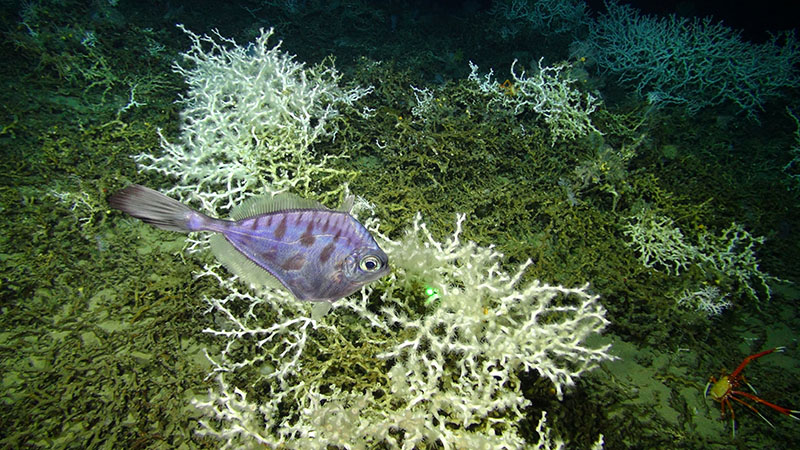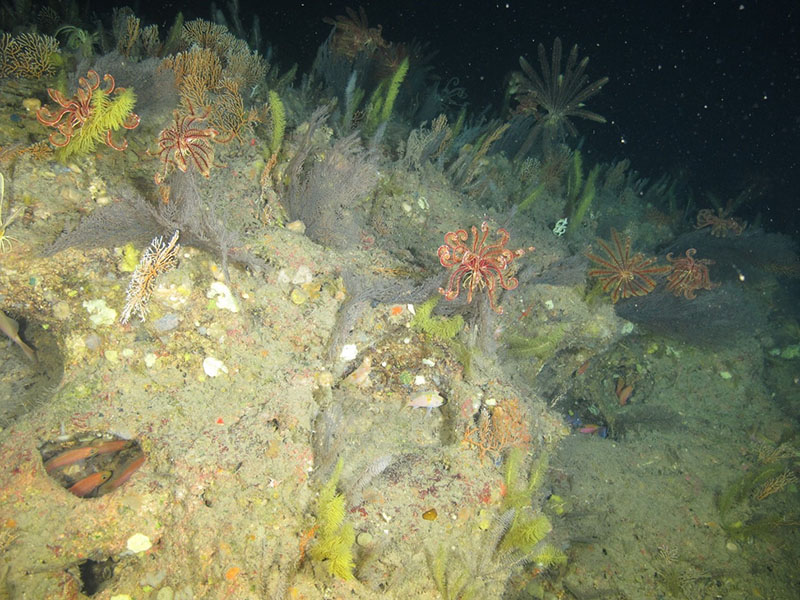In 2016, NOAA’s Deep-Sea Coral Research and Technology Program started a four-year initiative to study deep-sea coral and sponge ecosystems off the Southeast U.S., a region including the U.S. federal waters of the Caribbean, Gulf of Mexico and South Atlantic Bight. The initiative is a NOAA cross-line office effort that works in close collaboration with federal and academic partners to collect scientific information needed to manage deep-sea coral ecosystems.
Why We Care
Deep-sea corals, also known as cold-water corals, are corals that do not rely on sunlight, and therefore are typically found in deeper waters (>50 m). Deep-sea corals occur in all oceans, and under favorable conditions, form dense aggregations that create habitat for a myriad of species. These ecosystems are some of the richest and most diverse in the deep sea, yet they are often overlooked by managers, scientists and the general public, who may be unaware that rich and diverse communities can thrive in deep waters under the right conditions. While deep-sea coral ecosystems are out of sight and out of mind to most, they are not immune to anthropogenic impacts, as deep-sea trawling, oil and gas exploration, submarine cable laying and ocean acidification threaten these systems much more than their shallow-water counterparts. Deep-water corals are particularly vulnerable to such impacts, because they are typically slow growing and long lived (on the orders of centuries to millennia), and as a result require very long timescales to recover from disturbances. The objective of SEDCI is to study deep-sea coral ecosystems throughout the Southeast U.S. Region in order to further the management, conservation and protection of these important deep-water ecosystems.

What We Are Doing
SEDCI conducts multiple research expeditions each year, which survey deep-sea coral ecosystems using ships, submersibles, and other equipment. Additionally, SEDCI conducts complementary research projects focused on seafloor mapping, species identification, habitat suitability monitoring, environmental monitoring and data mining. These efforts will provide important baseline information that is needed to support management efforts of deep-sea coral ecosystems.
SEDCI focuses on studying deep-sea (>50 m) coral ecosystems off the Southeast U.S., a region including the U.S. federal waters of the Caribbean, Gulf of Mexico and South Atlantic Bight. This area corresponds to the cumulative extent of the jurisdictions of three fishery management councils, including the Caribbean, Gulf of Mexico and South Atlantic Fishery Management Councils. Furthermore, this area includes numerous areas where deep-water corals are protected, including three national marine sanctuaries, and various other marine protected areas. SEDCI focuses on surveying deep waters in and around these areas in order to support management efforts.

Benefits/Impact of Our Work
The priorities of SEDCI were developed in consultation with fishery management councils, national marine sanctuaries and other resource managers of the Southeast U.S., including partners from the Bureau of Ocean and Energy Management (BOEM) and the U.S. Geological Survey (USGS). There are several proposals for the establishment of new managed areas in deep waters off the Southeast U.S., including proposed expansions of the Flower Garden Banks National Marine Sanctuary, potential new habitat areas of particular concern in the Gulf of Mexico, and new special management zones in the U.S. South Atlantic. SEDCI expeditions will survey many of these proposed managed areas in 2016–2019, and thereby provide important information that is needed to evaluate these proposals.
Videos
- Living in the Dark: Expedition in Search of Deep-Sea Corals
(video courtesy of Ralf Meyer, Green Fire Productions)
- Flower Garden Banks National Marine Sanctuary R/V Manta 2017 expedition
(video courtesy of Eric Glidden, Undersea Vehicle Program at the University of North Carolina Wilmington)
